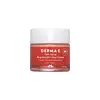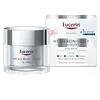What's inside
What's inside
 Key Ingredients
Key Ingredients

 Benefits
Benefits

 Concerns
Concerns

 Ingredients Side-by-side
Ingredients Side-by-side

Water
Skin ConditioningGlycerin
HumectantCaprylic/Capric Triglyceride
MaskingStearic Acid
CleansingCetyl Alcohol
EmollientGlyceryl Stearate Citrate
EmollientGlyceryl Stearate
EmollientPanthenol
Skin ConditioningDimethicone
EmollientSimmondsia Chinensis Seed Oil
EmollientTocopheryl Acetate
AntioxidantXanthan Gum
EmulsifyingCetearyl Glucoside
EmulsifyingAllantoin
Skin ConditioningPinus Pinaster Bark Extract
AntioxidantSodium Hydroxide
BufferingBakuchiol
AntimicrobialAstaxanthin
Skin ConditioningLavandula Angustifolia Oil
MaskingSalvia Officinalis Oil
MaskingLimonene
PerfumingPolysorbate 20
EmulsifyingRetinol
Skin ConditioningEucalyptol
PerfumingCopaifera Reticulata Balsam Oil
PerfumingMentha Viridis Leaf Oil
AstringentBeta-Caryophyllene
MaskingCamphor
MaskingCitral
PerfumingL-Alpha-Pinene
PerfumingGeranyl Acetate
PerfumingAnthemis Nobilis Flower Oil
MaskingL-Beta-Pinene
PerfumingMelaleuca Alternifolia Leaf Oil
AntioxidantIsobornyl Acetate
MaskingNeryl Acetate
PerfumingMenthone
PerfumingBenzyl Acetate
MaskingCitronellal
MaskingTerpineol
MaskingMenthyl Acetate
MaskingPhenoxyethanol
PreservativePotassium Sorbate
PreservativeEthylhexylglycerin
Skin ConditioningWater, Glycerin, Caprylic/Capric Triglyceride, Stearic Acid, Cetyl Alcohol, Glyceryl Stearate Citrate, Glyceryl Stearate, Panthenol, Dimethicone, Simmondsia Chinensis Seed Oil, Tocopheryl Acetate, Xanthan Gum, Cetearyl Glucoside, Allantoin, Pinus Pinaster Bark Extract, Sodium Hydroxide, Bakuchiol, Astaxanthin, Lavandula Angustifolia Oil, Salvia Officinalis Oil, Limonene, Polysorbate 20, Retinol, Eucalyptol, Copaifera Reticulata Balsam Oil, Mentha Viridis Leaf Oil, Beta-Caryophyllene, Camphor, Citral, L-Alpha-Pinene, Geranyl Acetate, Anthemis Nobilis Flower Oil, L-Beta-Pinene, Melaleuca Alternifolia Leaf Oil, Isobornyl Acetate, Neryl Acetate, Menthone, Benzyl Acetate, Citronellal, Terpineol, Menthyl Acetate, Phenoxyethanol, Potassium Sorbate, Ethylhexylglycerin
Water
Skin ConditioningGlycerin
HumectantButyl Methoxydibenzoylmethane
UV AbsorberEthylhexyl Salicylate
UV AbsorberOctocrylene
UV AbsorberButylene Glycol
HumectantGlyceryl Stearate Citrate
EmollientHydrogenated Coco-Glycerides
EmollientButyrospermum Parkii Butter
Skin ConditioningDimethicone
EmollientMethylpropanediol
SolventStearyl Alcohol
EmollientCetyl Alcohol
EmollientGlycine Soja Germ Extract
EmollientSodium Hyaluronate
HumectantMica
Cosmetic ColorantSilica
AbrasiveAcrylates/C10-30 Alkyl Acrylate Crosspolymer
Emulsion StabilisingCarbomer
Emulsion StabilisingTrisodium EDTA
1,2-Hexanediol
Skin ConditioningPhenoxyethanol
PreservativeParfum
MaskingBHT
AntioxidantCI 77891
Cosmetic ColorantWater, Glycerin, Butyl Methoxydibenzoylmethane, Ethylhexyl Salicylate, Octocrylene, Butylene Glycol, Glyceryl Stearate Citrate, Hydrogenated Coco-Glycerides, Butyrospermum Parkii Butter, Dimethicone, Methylpropanediol, Stearyl Alcohol, Cetyl Alcohol, Glycine Soja Germ Extract, Sodium Hyaluronate, Mica, Silica, Acrylates/C10-30 Alkyl Acrylate Crosspolymer, Carbomer, Trisodium EDTA, 1,2-Hexanediol, Phenoxyethanol, Parfum, BHT, CI 77891
Ingredients Explained
These ingredients are found in both products.
Ingredients higher up in an ingredient list are typically present in a larger amount.
Cetyl Alcohol is a fatty alcohol. Fatty Alcohols are most often used as an emollient or to thicken a product.
Its main roles are:
Though it has "alcohol" in the name, it is not related to denatured alcohol or ethyl alcohol.
The FDA allows products labeled "alcohol-free" to have fatty alcohols.
Learn more about Cetyl AlcoholDimethicone is a type of synthetic silicone created from natural materials such as quartz.
What it does:
Dimethicone comes in different viscosities:
Depending on the viscosity, dimethicone has different properties.
Ingredients lists don't always show which type is used, so we recommend reaching out to the brand if you have questions about the viscosity.
This ingredient is unlikely to cause irritation because it does not get absorbed into skin. However, people with silicone allergies should be careful about using this ingredient.
Note: Dimethicone may contribute to pilling. This is because it is not oil or water soluble, so pilling may occur when layered with products. When mixed with heavy oils in a formula, the outcome is also quite greasy.
Learn more about DimethiconeGlycerin is already naturally found in your skin. It helps moisturize and protect your skin.
A study from 2016 found glycerin to be more effective as a humectant than AHAs and hyaluronic acid.
As a humectant, it helps the skin stay hydrated by pulling moisture to your skin. The low molecular weight of glycerin allows it to pull moisture into the deeper layers of your skin.
Hydrated skin improves your skin barrier; Your skin barrier helps protect against irritants and bacteria.
Glycerin has also been found to have antimicrobial and antiviral properties. Due to these properties, glycerin is often used in wound and burn treatments.
In cosmetics, glycerin is usually derived from plants such as soybean or palm. However, it can also be sourced from animals, such as tallow or animal fat.
This ingredient is organic, colorless, odorless, and non-toxic.
Glycerin is the name for this ingredient in American English. British English uses Glycerol/Glycerine.
Learn more about GlycerinGlyceryl Stearate Citrate is a citric acid ester of glyceryl stearate.
It is an emulsifier, emollient, and a surfactant.
Emulsifiers help stabilize a product. It does this by preventing certain ingredients from separating. Common ingredients include oils and water, which do not mix naturally. Emulsifiers have properties that help keep ingredients such as these together.
Emollients help soothe and soften the skin. They do this by creating a protective film on your skin. This barrier helps trap moisture and keeps your skin hydrated. Emollients may be effective at treating dry or itchy skin.
Surfactants help gather oils, dirt, and other pollutants from the skin. This helps them to be easily rinsed away.
Learn more about Glyceryl Stearate CitratePhenoxyethanol is a preservative that has germicide, antimicrobial, and aromatic properties. Studies show that phenoxyethanol can prevent microbial growth. By itself, it has a scent that is similar to that of a rose.
It's often used in formulations along with Caprylyl Glycol to preserve the shelf life of products.
Water. It's the most common cosmetic ingredient of all. You'll usually see it at the top of ingredient lists, meaning that it makes up the largest part of the product.
So why is it so popular? Water most often acts as a solvent - this means that it helps dissolve other ingredients into the formulation.
You'll also recognize water as that liquid we all need to stay alive. If you see this, drink a glass of water. Stay hydrated!
Learn more about Water